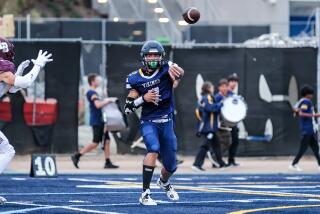Hagins Hopes to Be a Hit at San Diego State
- Share via
Being forced to fight a university to play baseball wasn’t the toughest part, Stephan Hagins says, but it was a close second--very close.
Hagins would have been OK except for those annoying voices of self-doubt; the ones that grew louder the longer he was kept away from the game. If only he hadn’t started wondering if he could still play.
The last 18 months almost seem like somebody else’s life or, rather, nightmare.
On Friday, Hagins will run onto a baseball field with his San Diego State teammates. The Aztecs open the season at Grand Canyon of Phoenix.
The game is the first of Hagins’ college career, which has been delayed two seasons because of a legal battle with a university about his health. Finally, Hagins has a chance to display the skills that made him a Times all-county first-team catcher at University High.
“You know, I’ve overcome a lot in the last year and a half,” said Hagins, 19. “All the controversy and stuff, I thought I had no chance to come back.
“Well, I am back now. So people better watch out.”
And what a tumultuous journey it has been.
Hagins’ life had been wonderful not so long ago. As a senior at University, Hagins was rated one of the top prospects in the nation by the Major League Scouting Bureau. He also had the option to play for one of the nation’s elite college programs when he signed with Arizona State.
Pro scouts and Arizona State coaches were aware that Hagins has a heart valve defect. However, they weren’t scared away because Hagins had been cleared to play through high school. Moreover, he dominated at a high level of competition, batting .507 as a senior.
But on June 1, 1993, only two days before the free-agent draft, Hagins’ father died of heart failure at age 60. Apparently worried that Hagins’ condition was hereditary and posed more of a potential problem, pro baseball backed off.
A probable first-round pick before his father’s death, Hagins was drafted in the 23rd round by the Cleveland Indians. Hagins opted to enroll at Arizona State.
But things got worse.
Hagins’ condition, known as aortic stenosis--which involves a defective heart valve that can be clogged over a period of time--worsened. He underwent a 5 1/2-hour medical procedure, called balloon aortic valvuplasty, at UCLA Medical Center to clear the valve. Hagins said doctors told him his condition improved dramatically after the procedure.
Arizona State refused to allow Hagins to play and he filed a lawsuit. Hagins dropped the suit in exchange for ASU releasing him from his letter of intent.
Pepperdine was his first choice for a new school, but Hagins said its administration also apparently had concerns. Hagins enrolled at San Diego State in January, 1994, and was a redshirt last season. Hagins said he has received medical clearance to play from several doctors.
“I feel good that someone finally wants me,” he said. “There were times I wondered if I’d ever wear a uniform again. When you don’t play as long as I have, you start losing your confidence.”
Hagins (6 feet 1 and 210 pounds) continued to lift weights and take batting practice at Arizona State and during his redshirt season at San Diego State. He has four seasons of eligibility.
However, no amount of practice can simulate game competition. He wasn’t sure if he still had “it.”
Until the summer.
Hagins was one of the best players in the Alaska League, a summer developmental league for the nation’s top college players. In 55 games, he batted .320 with five home runs and 45 runs batted in.
“Going in, I had no clue if I could still play,” Hagins said. “It was really rough because I didn’t know what would happen if I didn’t hit. But I did really well.”
His progress continued during the Aztecs’ preseason practice. He expects to be the team’s starting catcher and designated hitter. Hagins still must follow a specialized conditioning program.
“He’s been away from it for a while but he’s coming along real nicely,” San Diego State Coach Jim Dietz said.
Although he says he believes he’s back physically, Hagins said he’s working on the mental part.
“I’m not in prime condition there,” he said. “I need to experience college ball to get my confidence.
“I need to get into Division I baseball to show I can do it.”
Not that Hagins has any doubts. In fact, he expects to be a star.
“I expect a very big season,” Hagins said. “I’ve worked very hard and I deserve a great season. I’m hitting the ball well enough to be an All-American. There’s no doubt in my mind.”
*
The big chief: Duke senior center-forward Cherokee Parks (Marina High) is among the Atlantic Coast Conference’s leaders in scoring, rebounding, blocked shots, field-goal and free-throw percentage.
Parks is tied for fourth in the ACC with an average of 20.4 points. He is third in rebounding at 9.4 per game, ninth in blocked shots at 1.8, 10th in field goals (53.4%) and fifth in free throws (78.2%).
He scored a career-high 29 points Tuesday night in Duke’s 87-64 victory over Notre Dame at South Bend, Ind.
*
Top player II: Nevada Las Vegas senior center Tracy Titus (Loara High) was chosen the Big West Conference’s player of the week (Jan. 23) for the second time this season.
Titus averaged 18.5 points and 14 rebounds in leading UNLV to conference victories over San Jose State (75-59) on Jan. 20 and Hawaii (72-61) on Jan. 22. Titus also won the award Dec. 28.
She is eighth in the conference in scoring at 14.6 points per game and fifth with an 8.5 rebound average.
*
No. 2 guy: Junior forward Jason Senik (El Toro High) is the second-leading scorer for Wheaton College, a Division III school in Wheaton, Ill.
Senik averages 14.1 points. He shoots 53% from three-point range and averages 3.8 rebounds.
Keeping Track is a regular column in The Times following the progress of former Orange County athletes competing for colleges elsewhere.
More to Read
Go beyond the scoreboard
Get the latest on L.A.'s teams in the daily Sports Report newsletter.
You may occasionally receive promotional content from the Los Angeles Times.










